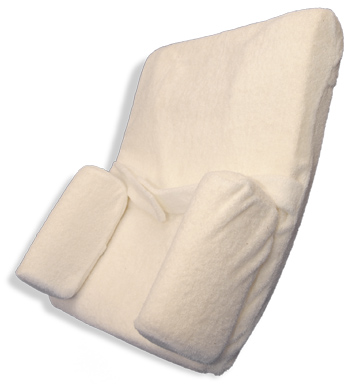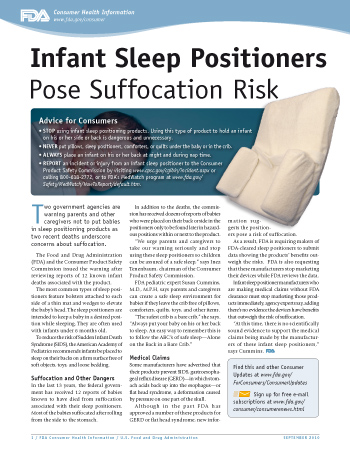For Consumers
Infant Sleep Positioners Pose Suffocation Risk
See more images of |
 Infant Sleep Positioner Example |
 Get Consumer Updates by E-mail
Get Consumer Updates by E-mail
Two government agencies are warning parents and other caregivers not to put babies in sleep positioning products as two recent deaths underscore concerns about suffocation.
The Food and Drug Administration (FDA) and the Consumer Product Safety Commission issued the warning after reviewing reports of 12 known infant deaths associated with the products.
The most common types of sleep positioners feature bolsters attached to each side of a thin mat and wedges to elevate the baby’s head. The sleep positioners are intended to keep a baby in a desired position while sleeping. They are often used with infants under 6 months old.
To reduce the risk of Sudden Infant Death Syndrome (SIDS), the American Academy of Pediatrics recommends infants be placed to sleep on their backs on a firm surface free of soft objects, toys, and loose bedding.
Advice for Consumers
STOP using infant positioning products. Using this type of product to hold an infant on his or her side or back is dangerous and unnecessary.
NEVER put pillows, sleep positioners, comforters, or quilts under the baby or in the crib.
ALWAYS place a baby on his or her back at night and during nap time.
REPORT an incident or injury from an infant sleep positioner to the Consumer Product Safety Commission by visiting www.cpsc.gov/cgibin/incident.aspx or calling 800-638-2772, or to FDA's MedWatch program.
Suffocation and Other Dangers
In the last 13 years, the federal government has received 12 reports of babies known to have died from suffocation associated with their sleep positioners. Most of the babies suffocated after rolling from the side to the stomach.
In addition to the deaths, the commission has received dozens of reports of babies who were placed on their back or side in the positioners only to be found later in hazardous positions within or next to the product.
“We urge parents and caregivers to take our warning seriously and stop using these sleep positioners so children can be assured of a safe sleep,” says Inez Tenenbaum, chairman of the Consumer Product Safety Commission.
FDA pediatric expert Susan Cummins, M.D., M.P.H, says parents and caregivers can create a safe sleep environment for babies if they leave the crib free of pillows, comforters, quilts, toys, and other items.
“The safest crib is a bare crib,” she says. “Always put your baby on his or her back to sleep. An easy way to remember this is to follow the ABC’s of safe sleep—Alone on the Back in a bare Crib.”
Medical Claims
Some manufacturers have advertised that their products prevent SIDS, gastroesophageal reflux disease (GERD)—in which stomach acids back up into the esophagus—or flat head syndrome, a deformation caused by pressure on one part of the skull.
Although in the past FDA has approved a number of these products for GERD or flat head syndrome, new information suggests the positioners pose a risk of suffocation.
As a result, FDA is requiring makers of FDA-cleared sleep positioners to submit data showing the products’ benefits outweigh the risks. FDA is also requesting that these manufacturers stop marketing their devices while FDA reviews the data.
Infant sleep positioner manufacturers who are making medical claims without FDA clearance must stop marketing those products immediately, agency experts say, adding there’s no evidence the devices have benefits that outweigh the risk of suffocation.
“At this time, there is no scientifically sound evidence to support the medical claims being made by the manufacturers of these infant sleep positioners,” says Cummins.
This article appears on FDA's Consumer Updates page, which features the latest on all FDA-regulated products.
Posted: September 29, 2010
For More Information
CPSC: Consumer Blog CPSC and FDA Warn Against Using Infant Sleep Positioners Because of Suffocation Risk: Initial Communication Muertes suscitan advertencia de la CPSC y FDA sobre los posicionadores de dormir infantiles Letter to Manufacturers Concerning Medical Claims About Infant Sleep Positioners: Devices Can Create Risk of Suffocation Letter to Manufacturers of 510(k)-cleared Infant Positioners: Devices Can Create Risk of Suffocation NIH: Back to Sleep Campaign NIH: Preventing Sudden Infant Death AAP Policy Statement on SIDS 
FDA and CPSC: Don't Use Infant Sleep Positioners (YouTube) 









